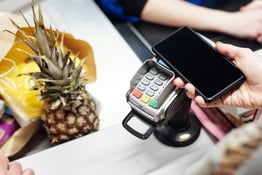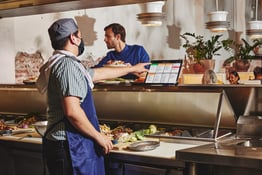You know when you call a company, and instead of a human answering the phone, you’re forced to navigate through a clunky robotic bot system, repeating yourself over and over again, until you can finally get your question answered? We’ve all been there. And it’s a problem that Alex Sambvani and Gabriel Duncan want to fix.
In 2019, the former Spotify engineers teamed up to create Slang.ai, an AI-powered phone answering service that uses brand-customizable language and voice features. It’s designed to make callers feel closer to as if they were talking to an actual human, while helping larger and understaffed companies ensure calls aren’t going missed. Naturally, this has led restaurant operators to take a look at the technology.
“These days, a lot of times restaurants aren’t answering the phone at all because of current staffing challenges and wage levels,” says Sambvani. “Guests are left hanging, and it’s also bad for operators because they’re leaving money on the table – if you’re not answering the phone, you’re missing out on reservations, catering orders, potential private dining buyouts, and other major transactions.”
With Slang, restaurants can filter callers’ questions and eliminate the need for staff to answer every single one. Slang will automatically answer the simple questions, like those about location, hours, and parking. For more complex topics, Slang can route callers directly to a staff member or send callers follow-up actions by text message, like a link to the restaurant’s online ordering platform when someone calls about takeout. Slang says restaurants currently save an average of 200-plus hours per month by using the software.
We chatted with Sambvani to learn more about how the technology works and to get his thoughts on the future of AI in the restaurant industry.
I know you work with a wide variety of clients. Can you share more on some of the ways Slang specifically caters to restaurants?
We help restaurant operators streamline their phone calls through an AI-powered answering service. Imagine it like if you could train an Amazon Alexa to answer your phones the exact way that you want them to be answered, every single time. With Slang, if you wanted catering calls to be routed directly to your catering director’s cell phone, for example, you can do that. If you want catering calls to be routed to an online submission form or app, you can also do that. And the same goes for other calls, like questions about reservations. You choose what language is used, what the follow-up action is, and where the guest is sent on their journey.
It’s about using AI to make your operations more efficient by freeing up staff, capturing more opportunities, and leveling up your guest experience.
What are the main differences between AI-powered phone answering services and more traditional, virtual restaurant answering services?
There’s traditional phone software, like a Verizon or a Spectrum or a RingCentral, where you pay those companies to power the phones in your restaurants. A guest calls, and it rings a physical phone. We compliment that by sitting on top of whatever physical phone service you’re already using as an AI-layer that filters your calls and answers the easy ones quickly, while forwarding the ones you want to get through to your staff.
There are other answering services that are human-powered, like an outsourced remote call center. That’s just a different route, and so it depends on what you need, your budget, and how much capacity you have to train an external team to really know your brand. Our product is meant to be a tech-forward solution you can set up in 30 minutes or less and is super easy to test.
What do you see as the top benefits of restaurants adopting an automated phone answering service like Sling?
The biggest reason why customers come to us is because they know they’re missing out on opportunities – missing reservations, catering orders, and takeout orders because the phone isn’t being answered enough.
The second benefit is freeing up staff time. Staff spends a ton of time answering phone calls that are repetitive, and it’s a huge distraction. Imagine a host trying to check someone in, but they’re interrupted by phone calls every few seconds. We can automatically handle those common questions, like “Where can I find parking?”, so that your staff can get back time to spend on the guests within the four walls of the restaurants.
Reason number three is the guest experience. It’s just not a good experience for your diners to call and not get a response. It might feel counterintuitive to have an AI-system answering your phone when hospitality is your biggest goal. But we’ve found that using automation carefully frees up staff for those interactions that really need to be higher touch.
Would you say Slang makes more sense for a multi-unit chain than a one-off independent restaurant, or who would you say your target audience is when it comes to the restaurant sector?
We have customers across all segments. Our biggest segment is multi-unit, full-service, but we also work with some really big brands in the QSR space, some fast-casuals, and one-off restaurants.
The real deciding factor in if our product is a good fit is if a restaurant’s getting some call volume, I’d say at least 100 phone calls a month. But we have one-off operators that are doing thousands of calls a month because they have a really popular brand, and so it’s really about, does the operator feel like they're missing opportunities over the phone?
Let’s say an operator signs up for Slang – can you give me an overview of the setup process?
Once you sign up, you’ll get a ping from our onboarding team. They do some upfront research on your restaurant and set up the system ahead of time. Then, they’ll do a 30-minute onboarding call to educate how the product works and how to make updates to the system.
When you onboard, you get access to a dashboard that has pre-programmed questions. Based on the type of restaurant you are, we know what types of calls you’re going to get. You’ll walk through those questions with the onboarding manager and make sure each is being handled the way you want it to be.
They’ll go over questions like, “Should we tweak any of the standard language around how we address making reservations, or change the tone to make it more casual or funny?” They’ll also do fun things like sample digital voices with you. We’ve invested in dozens and dozens of voice options so that the voice can fit your brand. If you want an Australian voice, a British voice – whatever you want, we can probably support it. You can also add background music to make it more on-brand. And if you have a high-volume question that the software’s not set up to answer, you can also add custom questions.
How are restaurants using this type of technology to handle online ordering?
Callers either get forwarded directly to the restaurant, or operators send a link that directly routes their diners to their online ordering solution. In other words, operators are using Slang to make sure orders are among the only types of calls going to the restaurant, or they’ll have Slang automatically text the caller, and this maximizes the likelihood that the guest actually places an order, as opposed to just hearing a voicemail that says, “You can find us online.” or “Check us out on DoorDash.”
Can you share a few examples of common questions that are pre-populated by Slang for restaurants?
Making a reservation is the biggest question in full-service. There are also questions about changing a reservation, running late, location, hours of operation, walk-in and wait time inquiries, booking private events and private dining, finding a contact to book large parties, placing an order for takeout, catering, and whether or not there’s a brunch menu.
So what’s the typical process if a guest calls a restaurant and asks to make a reservation?
When we first started the business, reservation links were sent to callers by text message. But now we’re taking that a step further by working on end-to-end reservation management. If you’re on OpenTable, we can book guests directly and also mark a guest running late or cancel a reservation. We’re also working on something with SevenRooms, Resy, and Toast, so that’ll eventually be live with other platforms.
What does it look like when a customer calls and asks to speak with a person?
If someone wants to speak to a host or manager, we forward the call immediately. That assumes the restaurant’s staffed to answer some calls. We do have restaurants where they don’t have the staff, and if that’s the case, we leave it to the operator to figure out the best way to route the customer. It could be routing them to an email, so recording a message that says, “We’re so sorry, we’re not staffed to answer the phone right now. You can send us an email, and to save you time, I can send you a text message with that email right now.”
What kinds of data reports do operators get through Slang?
Out of the box, you get an analytics dashboard with stats like how many calls you’re getting, how many text messages the virtual concierge is sending, what percentage of the calls were handled successfully, and how much time Sling has saved you. You also get to see your call volume by day of the week and time of day, which helps inform staffing decisions.
Then we also show what people are actually calling about, and you can break that down by day. If you’re a multi-unit operator, you can look at that across locations and understand if your guest preferences are different across locations or if you’re having operational issues. Maybe one location is getting five times the amount of complaints as another location. There's a lot of signals that can help you understand what's going on.
For some of our multi-unit operators and even our one-off operators on a select basis, we also do custom reporting.
How do you see this type of AI technology continuing to evolve?
Everyday, we see AI technology continue to get more sophisticated, and specifically when it comes to restaurants, we’ll continue to see it evolve to handle more complex scenarios, like handling voice orders end-to-end. It can’t do that very well yet, but it will get there.
The other thing it’ll be able to do is have more personality. If you give the AI the customer’s data, and it knows all of the transactions they’ve done with the business, it could greet you with, “Hey Alex, how are you doing today? Are you hoping to order the usual, the chicken sandwich with our special sauce?” We’re pretty close to being able to do that, where every single conversation is a unique, personalized experience, to make it sound even more human.
The voices are also going to get better and better. Three years ago, the voices were pretty robotic, but some of the new voices that are coming out sound almost indistinguishable from human voices. And there may be opportunities in the future to clone your own voice.
What role do you see AI ultimately playing in the future of the restaurant industry?
Every restaurant will be using some form of AI – there are tons of robotics and automation companies popping up. I believe voice AI specifically will be a core part of every operator’s tech stack, whether that’s via phone, through the drive-thru, or [as part of an] in-person [ordering process].
I also think the next phase will be even more proactive – using AI to allow restaurants to reach out to guests in a way that’s relevant and beneficial. With our AI product, for example, we can identify all guests who asked about catering. So it could be something like, do we send them a personalized text message to give them a catering offer to order from us again? Maybe we even get to a world where the voices are so personalized and fun that people actually enjoy getting an outbound call if they’re getting a special offer from a brand they have a relationship with, even if it’s automated, and that gets them to come visit. We’re already seeing that in other industries, and I think it’ll spread to restaurants.
To learn about pricing, visit Slang's pricing page. Plans start at $199 per month.





